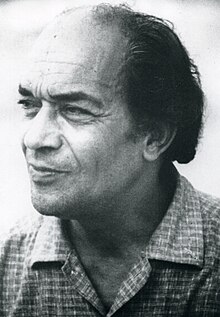Mohammed Khadda
Mohammed Khadda محمد الخدة | |
|---|---|
 Mohammad Khadda in 1981 | |
| Born | 14 March 1930 |
| Died | 4 May 1991 (aged 61) |
| Known for | Painting, Arabic Calligraphy |
Mohammed Khadda (Arabic: محمد الخدة; 14 March 1930 – 4 May 1991) was an Algerian painter, sculptor, and writer. Khadda has been considered to be among the founders of contemporary Algerian painting and one of the many representatives of the "sign painters."[1] He debuted in 1960. His influences included Cubism and Arabic calligraphy. He tended toward the non-figurative or abstract.[2][3] He represented a generation of Algerian artists who combined the ideas of calligraphic heritage and formal language of Western formal writing through Western abstraction through the 1950s.[4]
Biography
Born in Mostaganem,[5] Mohammed Khadda was the eldest of five children, two of whom died while infants. His father, Bendehiba Khadda, was born in 1912 in the town of Mina and moved to Mostaganem at a very young age. He was born blind, yet held various occupations such as a bricklayer and a dock worker. Khadda’s mother, Nebi El Ghali was born in 1911 in Zemora, Algeria, a city near Tiaret. When she was a little girl, her parents were murdered by a settler tribe near where she lived. She, like Mohammed’s father, was also blind, but managed to adjust. Benedehiba and Nebi met in Mostaganem and were married in 1929.
In 1936, Mohammed Khadda attended a school in Tigditt, Mostaganem in an Arab neighborhood. In 1942, he and his family had to leave Mostaganem because of a famine in the area. The family moved to Tiaret and they moved in with his aunt. It was miserable there because their aunt couldn’t provide for them due to her age. Three months later, he returned to Mostaganem and he went back to school. In 1943, he received a diploma from the school. His father wanted him to get a job as soon as he received his diploma, but one of his teachers gave him a year of respite so he did not have to settle for a job he did not enjoy. In 1944, Khadda found a job at a printing company called “Ain Sefra.” During the day, Khadda would draw and make sketches for the printing company. He decided to take on a second job in the evening, binding books for different writers such as Omar Khayyam, Abdou Mohammed, Taha Hussein, Hafid, Jami, André Gide, André Breton, and Jean Cocteau. During the years of resistance against the French, many artists including Khadda went and fought for the National Liberation Army. After finishing with the army, he settled down and his career as an artist slowly began.
Art
Often working with a palette of earth tones, Khadda created tactile compositions that layer Arabic writing and calligraphy over atmospheric abstract canvases.[4] For the most part, Mohammed Khadda was a self-taught painter of abstract compositions. He used Arabic characters and signs taken from Berber tattoos in his artwork. Though he was self-taught for part of his life, he also had connections with art schools. In 1947, Khadda met Abdallah Benantaur, an artist born in Mostaganem a year after Khadda was born. After their encounter, Khadda enrolled in an École des Beaux-arts [College of Fine Arts] where he learned different art techniques such as watercolors, pastels, and paintings. He continued to expand on his painting techniques by painting scenes of meetings in bookstores and flea markets. In 1948, he and Benantaur went to visit a friend in a hospital sanatorium. It was during this visit that Khadda saw the Museum of Fine Arts where he was inspired by paintings by Eugène Delacroix, Eugène Fromentin, Théodore Chassériau, and Nasreddine Dinet. He was also influenced by sculptures by Auguste Rodin and Antoine Bourdelle.
In 1953, like many other artists from Africa, Mohammed Khadda traveled to Paris, France to continue his education. During that time, he studied under Pablo Picasso and learned the styles of Cubism which greatly influenced his art.[2] He spent a decade in Europe before returning to Algeria. After returning, he worked to set up an art community in Algeria for young aspiring artists to hone their potential skills. In 1964, he and others established the National Union of the Visual Arts. Khadda established the Sign Painters and School of the Sign in 1967. He also illustrated books for Rachid Boudjedra, Tahar Djaout, and others.
Important movements
Mohammed Khadda was involved in many art movements and organizations throughout his career that have and will continue to influence art in Africa and the rest of the world. Some of these include:
- National Union of the Visual Arts, 1967
- Aouchem (Arabic for tattoo) Art Movement, 1967[4]
- School of Sign, 1967
- "Sign Painters"[4]
- Created over 70 murals in the 1970s
- Fought with the National Liberation Army during French Resistance
Tribute
On 14 March 2020, Google celebrated his 90th birthday with a Google Doodle.[6]
See also
References
- ^ "Algeria". Grove Art Online: 1. 26 May 2010. Retrieved 7 November 2014.
- ^ ISBN 9781741790993.
- ^ "Mémoire de signes: l'abstraction chez Jean-Michel Atlan et Mohammed Khadda" in the French Review Archived 2014-01-31 at the Wayback Machine
- ^ a b c d "Mohammed Khadda". Barjeel Art Foundation. Retrieved 6 November 2014.
- ^ "Google honors late Algerian artist Mohammed Khadda with a doodle". Arab News. 14 March 2020.
- ^ "Mohammed Khadda's 90th Birthday". Google. 14 March 2020.
